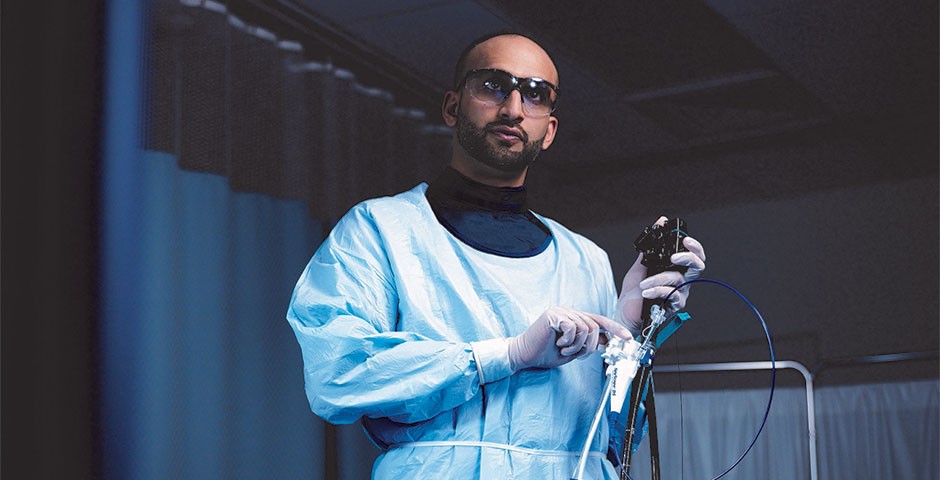Advancing Cholangioscopy

New Devices Advance Cholangioscopy
THE FIRST SINGLE-OPERATOR CHOLANGIOSCOPE, introduced in 2007, changed the way physicians approached cholangioscopy. By 2015, when digital technology was introduced, cholangioscopy was established as a reliable modality for diagnosing and treating pancreatic and biliary diseases.
TECHNICAL INNOVATION AND IMPROVED VISUALIZATION have helped to expand the applications of cholangioscopy. Today, physicians can better identify malignancies and provide a more accurate diagnosis.
Two new devices, the SpyGlass™ Retrieval Basket and SpyGlass Retrieval Snare, are continuing to expand the cholangioscopy platform. Compatible with the SpyScope™ DS Catheter, the new accessories add to a full suite of diagnostic and therapeutic devices designed for improved efficiency and management of patients with pancreatic and biliary stones and strictures.
The SpyGlass Retrieval Basket is designed to help physicians capture and remove stone fragments or residual stones during an ERCP procedure. Achieving single-stone session clearance may reduce the need for repeat procedures, reduce procedural costs and provide greater patient satisfaction.
“The SpyGlass Retrieval Basket is a valuable new tool to have in our armamentarium and further expands the therapeutic capabilities of the SpyGlass DS System, said Dr. Matthew Eves, Mobile, Alabama, “I am excited by the rapid expansion of our capacity to diagnose and treat biliary and pancreatic pathology that the SpyGlass platform has allowed.”
Physicians also now have a more efficient solution for removing migrated stents. The SpyGlass Retrieval Snare allows physicians to effectively remove foreign bodies in the biliary and pancreatic ducts, including migrated plastic stents during an ERCP procedure.
“In my opinion, the SpyGlass Retrieval Snare should be considered as a first option for retrieval of difficult-to-remove migrated bile duct and pancreatic stents, said Dr. Navakanth Gorrepati, Ft. Worth, Texas. “It facilitates easy retrieval and may help patients avoid repeat procedures or surgical intervention.”
The expanding application of cholangioscopy for stone and stricture management is helping to provide physicians with diagnostic and therapeutic tools to help manage patients with difficult stones and indeterminate strictures.
EXPANDED APPLICATIONS OF CHOLANGIOSCOPY
In addition to the new accessories, physicians are finding value in expanding cholangioscopy to other applications, including pre-surgical mapping and ablation.
Pre-surgical Mapping
The management of pancreatic and biliary cancers is complex and may involve a multidisciplinary team approach to develop the plan of care. Physicians are now turning to cholangioscopy for pre-surgical mapping as part of this approach. Understanding whether the disease is extensive or localized is vital information to have prior to surgery. Direct visualization may help physicians attain such information and further define mapping prior to surgical procedures.
“In my experience, high-resolution cholangioscopy has helped to define the extent of the disease accurately and has allowed for meaningful pre-operative planning for surgeons and more accurate staging, said Dr. Neil Sharma, Ft. Wayne, Indiana. “It also allows us to exclude or include borderline patients that would otherwise be opened for exploration for resection and stratify them to the appropriate treatment.”
A recent study examined the role of digital cholangiopan- creatoscopy technology in mapping the extent of malignant involvement in the biliary or pancreatic ducts before surgical intervention. Through an analysis of 118 patients, the surgical plan was altered in about one-third of patients (34 percent) when using direct visualization with the SpyGlass DS System.1
Pre-surgical mapping through cholangioscopy can not only help to define the surgical plan, but could facilitate the optimization of patient care. Knowing the extent of the disease may help patients avoid extensive or unnecessary surgery.
Ablation Procedures
Physicians are also turning to cholangioscopy to aid in ablation procedures. Endoscopic radiofrequency ablation can be effective for biliary drainage or decompression. Continuous innovation has enabled cholangioscopy to expand to new applications and provide physicians with the ability to more accurately diagnose and treat pancreatic and biliary conditions. Improvements have also provided patients with less invasive treatment options and the ability to avoid the need for repeat procedures or surgery. For the latest updates in cholangioscopy, visit Advancements in Cholangioscopy.
